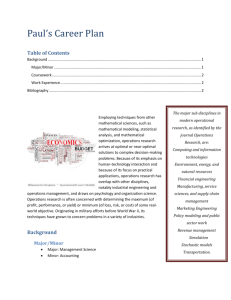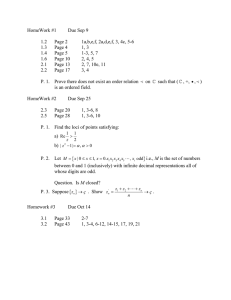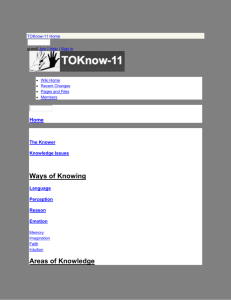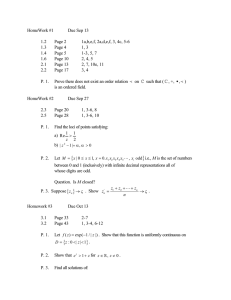Evaluation Summary Report Proposal number: Call: Instrument:
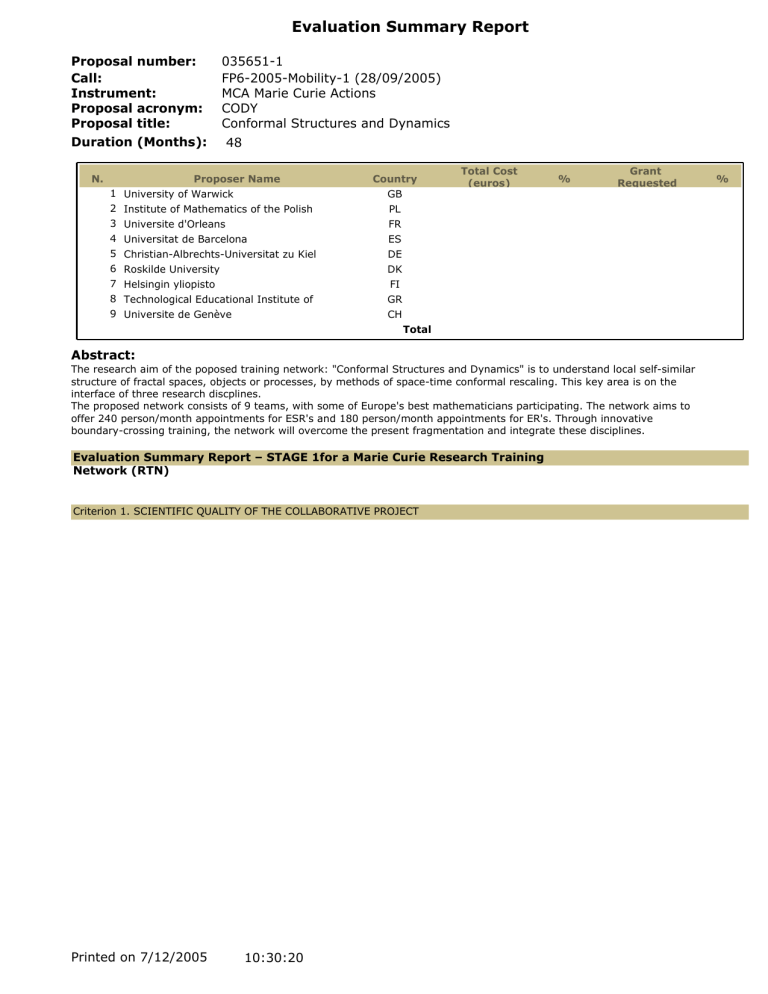
Evaluation Summary Report
Proposal number:
035651-1
Call:
Instrument:
FP6-2005-Mobility-1 (28/09/2005)
MCA Marie Curie Actions
Proposal acronym:
CODY
Proposal title:
Conformal Structures and Dynamics
Duration (Months):
48
N.
Proposer Name
1 University of Warwick
2 Institute of Mathematics of the Polish
3 Universite d'Orleans
4 Universitat de Barcelona
5 Christian-Albrechts-Universitat zu Kiel
6 Roskilde University
7 Helsingin yliopisto
8 Technological Educational Institute of
9 Universite de Genève
Country
GB
PL
FR
ES
DE
DK
FI
GR
CH
Total
Total Cost
(euros)
%
Grant
Requested
Abstract:
The research aim of the poposed training network: "Conformal Structures and Dynamics" is to understand local self-similar structure of fractal spaces, objects or processes, by methods of space-time conformal rescaling. This key area is on the interface of three research discplines.
The proposed network consists of 9 teams, with some of Europe's best mathematicians participating. The network aims to offer 240 person/month appointments for ESR's and 180 person/month appointments for ER's. Through innovative boundary-crossing training, the network will overcome the present fragmentation and integrate these disciplines.
Evaluation Summary Report – STAGE 1for a Marie Curie Research Training
Network (RTN)
%
Criterion 1. SCIENTIFIC QUALITY OF THE COLLABORATIVE PROJECT
Printed on 7/12/2005 10:30:20
Evaluation Summary Report
Proposal number:
035651-1
The research proposal adresses a very important and current topic and integrates different disciplines.
The project has a very strong multidisciplinary character linking mathematics and physics.
The expected results will lead to interesting applications such as image and data analysis, in robotics and non-holonomic mechanics.
Overcoming fragmentation is properly adressed.
The scientific project objectives are described in an excellent manner with relevant details. The project covers one of the most challenging recent mathematical areas of research, conformal mappings and all the related hot topics, like fractal structures, dynamical systems, and geometric theories, which explain the behavior of dynamics.
The project unifies the efforts of excellent teams and forms a very strong research body with a critical mass. This increases the probability of significant advances.
The state-of-the-art is fully demonstrated in the proposal.
The project is of very high scientific quality and its goals are realistic.
The methodology consists of combination of proven methods and very novel initiatives. All are at the forefront of recent mathematical research. The project expects new results from the synergy of different research fields.
Strengths of the proposals:
Integration of the disciplines of mathematics and physics.
The description and structure of the project and the scientific objectives are convincing and the potential for success is high.
Weaknesses of the proposal:
None
Overall comments:
This is a substantial project with a serious, impressive research plan and aim. The project brings together a unique pool of expert of different areas.
The envisioned theoretical results could lead to new applications.
The collaboration between these areas is not new, but such a planned large scale program would have a significant impact on the development to all of the involved fields as well as to the
European mathematical research community.
The applied side of the project would benefit from a more detailed plan of the industry-academia cooperation and communication. Ovearll it an almost excellent project.
Criterion 2. QUALITY OF THE TRAINING / TRANSFER OF KNOWLEDGE (ToK) ACTIVITIES
Printed on 7/12/2005 10:30:20
Evaluation Summary Report
Proposal number:
035651-1
The description of the RT/TOK is consistent with research program and it meets the goals and topics of it.
The training is designed to build cross disciplinary knowledge and transfer as it is done in the research plan.
Industry-academia collaboration is not a strong point but some nodes have industrial connections and experience.
The planned exchanges on different levels, workshops and conferences would lead to defragmentation of the related area.
In the plan there is a detailed scheme of career planning; the ESR will obtain a solid background for their work in science and industry.
An appropriate combination of local/network activity is proposed.
Complementary skill such as language courses are planned. Network level mathematical weekends provide opportunities for ESRs to gain lecturing experience.
Strengths:
The training program is well balance and complements the interdisciplinary character of the research plan.
A detailed scheme of career planning for the ESRs and their supervision by very high level scientists.
A good program for complementary skills training.
Weaknesses:
Rather high proportion ER/ESR (3:4)
Overall comments:
The training and TOK plan is as very good as the research plan. The nodes of the project have excellent training records which ensure that this side of the project will be a success.
The resource allocation given on the form A4 and on B are inconsistent.
TOTAL SCORE
Printed on 7/12/2005 10:30:20

